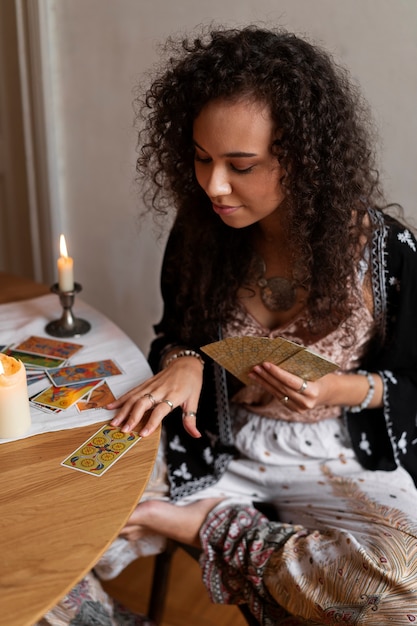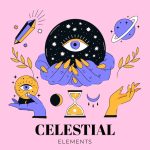
Welcome to the all-inclusive tarot reading guide! This guide is designed to be incredibly helpful as you dive into the intricate world of tarot. Whether you’re just curious, want to learn the history, get to know different decks, or aim to become an expert tarot reader, this guide covers it all. You’ll also find sections on choosing the right tarot spreads, preparing your cards for accurate readings, and interpreting tarot cards for yourself and others. Enjoy the captivating and enigmatic world of tarot cards!
Tarot cards originated in Europe during the 14th century as an Italian four-suited card game. The “Visconti-Sforza” deck from the mid-1440s was connected to Italian royalty, while other significant decks like the “Mantegna” (1470-1485) and the 15th-century Marseille gained popularity. By the 16th century, tarot became linked with mysticism. British astronomer John Dee reportedly used the cards to converse with angels, tying it to the Medieval Memory system, which used symbolic imagery.
In the 18th century, French occultist Antoine Court de Gébelin claimed that the 22 Major Arcana cards were based on ancient Egyptian wisdom. In the 19th century, researchers like Eliphas Levi connected tarot to the legendary Hebrew Enochian alphabet. By the late 19th century, social attitudes towards tarot shifted from simple fortune-telling to a powerful tool for gaining insights and spiritual discovery through interpreting the cards’ symbolism and archetypal imagery.
A standard tarot deck has 78 cards, each with various interpretations based on its images and meanings. The deck is divided into the Major Arcana and Minor Arcana. The Major Arcana consists of 22 numbered cards that depict universal themes and significant life experiences. The Minor Arcana has 56 cards organized into four suits: wands, cups, swords, and pentacles, each representing different elements and aspects of life—earth, water, air, and fire. Each card can have an upright or reversed meaning, which offers entirely different interpretations in a reading. Whether you prefer using just the upright meanings or also incorporating the reversed meanings depends on your preference and the specific questions you’re addressing.
Let’s explore some of the key cards in the tarot deck:
– **The Fool**: Symbolizes youth and inexperience. When it appears, embrace its accessible, enthusiastic energy and welcome the unknown without fear.
– **The Magician**: Recognizes your uniqueness and talents, indicating that you have the needed resources to achieve your goals.
– **The High Priestess**: Represents intuition and suggests following your inner voice.
– **The Empress**: Embodies understanding, elegance, and romance with a strong connection to nature.
– **The Emperor**: Represents authority and stability, often indicating career promotion or success in finding a new job.
Each suit in the Minor Arcana—Pentacles, Cups, Wands, and Swords—has 14 cards, including four court cards: Page, Knight, Queen, and King. These cards carry specific meanings:
– **Cups**: Emotions, intuition, and relationships.
– **Wands**: Initiative, creativity, and action.
– **Swords**: Challenges and intellectual pursuits.
– **Pentacles**: Career and financial matters.
Several well-known tarot decks have unique features and histories:
– **Rider-Waite Deck**: Created in 1909 by A.E. Waite and Pamela Colman Smith, known for its deep symbolism and comprehensive imagery.
– **Thoth Tarot Deck**: Designed by Aleister Crowley and Lady Frieda Harris, it incorporates elements like astrology and alchemy.
– **Wild Unknown Tarot**: Introduced in 2012 by Kim Krans, famous for its minimalist, nature-focused artwork.
– **Shadowscapes Tarot**: Created by Stephanie Pui-Mun Law, blending the traditional Rider-Waite imagery with her unique artistic style.
– **Gendron Tarot**: Published in 1991 by François Gendron, known for its striking visual style.
Different types of tarot readings offer various insights:
– **General Readings**: Provide overall insights into life circumstances.
– **Question-Based Readings**: Address specific questions or decisions.
– **Theme-Based Readings**: Focus on particular aspects like personal growth or relationships.
– **Past or Future Readings**: Examine how past or future events impact the present.
Preparing for a tarot reading involves connecting with your deck, shuffling the cards, and interpreting them while focusing on your query. The reading space should be peaceful, and it’s important to create an environment conducive to concentration.
When reading for others, establish clear boundaries and ensure the client is comfortable and informed about the reading process. Active listening, empathy, and respect are crucial for accurate and meaningful readings.
Different tarot spreads cater to various needs:
– **One-Card Spread**: For quick insights.
– **Three-Card Spread**: To explore past, present, and future or other specific themes.
– **Celtic Cross Spread**: A ten-card layout for comprehensive insights.
– **Pentagram Spread**: A five-card arrangement reflecting harmony and balance in life.
To prepare for a tarot reading, choose a reading type and prepare questions. Select a quiet environment, clear your mind of negative energy, and be open to the insights gained. Taking notes during the session can help you reflect on the messages later.
To cleanse your tarot deck, you can use different methods such as spreading the cards out and blowing over them, using crystals like clear quartz, or shuffling the deck multiple times. Personalizing your deck can also strengthen your connection to it.
Understanding conventional tarot card meanings and applying them to the current question is vital for an accurate reading. Trust your intuition and consider the relationships between the cards to gain deeper insights.
Reading tarot offers guidance on personal growth, relationships, and decision-making. It’s essential to interpret the cards using both traditional meanings and your intuition to provide meaningful readings.
Whether you’re a beginner or an advanced reader, trust your intuition, practice regularly, and continuously explore new techniques and spreads to enhance your tarot reading skills.


